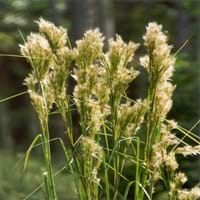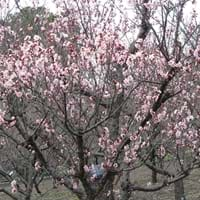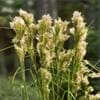Life Span
Perennial
Perennial
Origin
Caribbean, Central America
China, Korea
Types
Broomsedge Bluestem, Broomsedge
Not Available
Number of Varieties
Not Available
Habitat
ditches, Grassland, Moist Ditches, Moist Soils, Roadsides
All sorts of environments, Fertile bottom land, Well Drained
USDA Hardiness Zone
5-9
6-9
AHS Heat Zone
10 - 5
12-6
Sunset Zone
H1, 3a, 3b, 4, 5, 6, 7, 8, 9, 14, 15, 16, 17, 18, 19, 20, 21, 22, 23, 24
3a, 3b, 4, 5, 6, 7, 8, 9, 12, 13, 14, 15, 16, 17, 18, 19, 20, 21, 22
Habit
Upright/Erect
Oval or Rounded
Flower Color
Cream, Green, White
White, Pink, Rose
Flower Color Modifier
Bicolor
Bicolor
Fruit Color
Not Available
Yellow
Leaf Color in Spring
Green, Blue Green
Green
Leaf Color in Summer
Light Green
Green
Leaf Color in Fall
Gray Green, Yellow green, Bronze
Yellow, Light Yellow, Yellow green
Leaf Color in Winter
Gold, Tan, Bronze
Not Available
Leaf Shape
Grass like
Aristate
Plant Season
Fall, Winter
Spring, Winter
Sunlight
Full Sun, Partial Sun
Full Sun, Partial Sun
Type of Soil
Clay, Loam, Sand
Clay, Loam
The pH of Soil
Acidic, Neutral, Alkaline
Acidic, Neutral
Soil Drainage
Average
Well drained
Bloom Time
Late Summer, Early Fall, Fall, Late Fall, Early Winter
Early Spring, Early Winter, Winter, Late Winter
Tolerances
Not Available
Not Available
Where to Plant?
Ground
Ground
How to Plant?
Root Division, Seedlings
Budding, Seedlings
Plant Maintenance
Medium
Medium
Watering Requirements
Keep ground moist, Water Deeply
Average Water Needs, Does not require lot of watering, Water more frequently during periods of extreme drought
In Summer
Lots of watering
Lots of watering
In Spring
Moderate
Moderate
In Winter
Average Water
Average Water
Soil pH
Acidic, Neutral, Alkaline
Acidic, Neutral
Soil Type
Clay, Loam, Sand
Clay, Loam
Soil Drainage Capacity
Average
Well drained
Sun Exposure
Full Sun, Partial Sun
Full Sun, Partial Sun
Pruning
Cut or pinch the stems, Remove damaged leaves, Remove dead branches, Remove dead leaves
Remove damaged leaves, Remove dead branches, Remove dead leaves
Fertilizers
All-Purpose Liquid Fertilizer
All-Purpose Liquid Fertilizer, Apply N-P-K, fertilize in growing season
Pests and Diseases
Red blotch
Pests and diseases free, Red blotch
Plant Tolerance
Drought
Drought, Full Sun
Flower Petal Number
Single
Single
Foliage Texture
Coarse
Medium
Foliage Sheen
Matte
Not Available
Attracts
Birds, Butterflies
Birds
Allergy
Not Available
Not Available
Aesthetic Uses
Ground Cover
Not Used For Aesthetic Purpose
Beauty Benefits
Not Available
Not Available
Environmental Uses
Air purification, Food for animals, Food for birds, Provides ground cover, Wildlife
Air purification
Medicinal Uses
Not Available
antimicrobial, Gastrointestinal disorders, Ulcers
Part of Plant Used
Seeds
Flowers, Fruits
Other Uses
Used as Ornamental plant
Sauces, Sometimes used for making wine
Used As Indoor Plant
No
No
Used As Outdoor Plant
Yes
Yes
Garden Design
Container, Dried Flower/Everlasting, Feature Plant, Mixed Border, Rock Garden / Wall
Feature Plant, Fruit / Fruit Tree, Shade Trees, Street Trees
Botanical Name
ANDROPOGON glomeratus
PRUNUS mume
Common Name
Bushy Beardgrass, Bushy Bluestem, Bushy Broom Grass
Japanese Apricot
In Hindi
Bushy Bluestem plant
जापानी खुबानी
In German
Bushy Bluestem Pflanze
japanische Aprikose
In French
plante buissonnante Bluestem
abricot japonais
In Spanish
planta arbustiva andropogon
albaricoque japonés
In Greek
φυτό θαμνώδη BLUESTEM
Ιαπωνικά Βερίκοκο
In Portuguese
planta arbustiva Bluestem
Apricot japonês
In Polish
Krzaczaste Bluestem roślin
japońska morela
In Latin
Bushy bluestem herba
Persicum Italica
Phylum
Magnoliophyta
Tracheophyta
Class
Liliopsida
Magnoliopsida
Clade
Angiosperms, Commelinids, Monocots
Angiosperms, Eudicots, Rosids
Tribe
Andropogoneae
Not Available
Subfamily
Panicoideae
Not Available
Number of Species
Not Available
Season and Care of Bushy Bluestem and Japanese Apricot
Season and care of Bushy Bluestem and Japanese Apricot is important to know. While considering everything about Bushy Bluestem and Japanese Apricot Care, growing season is an essential factor. Bushy Bluestem season is Fall and Winter and Japanese Apricot season is Fall and Winter. The type of soil for Bushy Bluestem is Clay, Loam, Sand and for Japanese Apricot is Clay, Loam while the PH of soil for Bushy Bluestem is Acidic, Neutral, Alkaline and for Japanese Apricot is Acidic, Neutral.
Bushy Bluestem and Japanese Apricot Physical Information
Bushy Bluestem and Japanese Apricot physical information is very important for comparison. Bushy Bluestem height is 120.00 cm and width 75.00 cm whereas Japanese Apricot height is 550.00 cm and width 550.00 cm. The color specification of Bushy Bluestem and Japanese Apricot are as follows:
Bushy Bluestem flower color: Cream, Green and White
Bushy Bluestem leaf color: Green and Blue Green
Japanese Apricot flower color: White, Pink and Rose
- Japanese Apricot leaf color: Green
Care of Bushy Bluestem and Japanese Apricot
Care of Bushy Bluestem and Japanese Apricot include pruning, fertilizers, watering etc. Bushy Bluestem pruning is done Cut or pinch the stems, Remove damaged leaves, Remove dead branches and Remove dead leaves and Japanese Apricot pruning is done Remove damaged leaves, Remove dead branches and Remove dead leaves. In summer Bushy Bluestem needs Lots of watering and in winter, it needs Average Water. Whereas, in summer Japanese Apricot needs Lots of watering and in winter, it needs Average Water.





